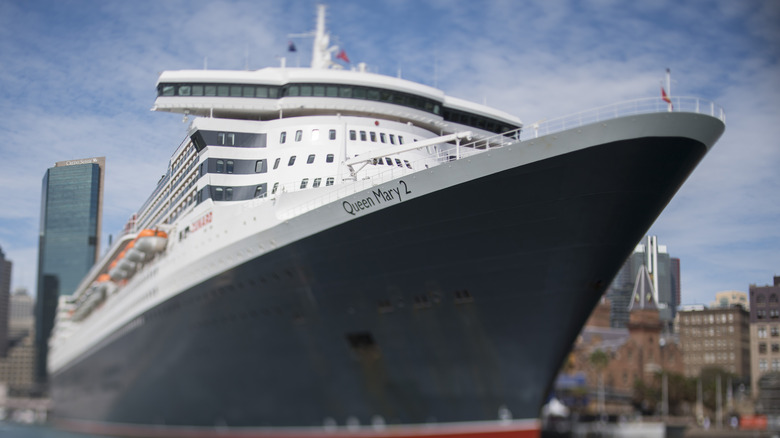What's The Difference Between The Last Ocean Liner In The World And A Regular Cruise Ship
There was once a time when ocean liners ruled the seas. Built for speed and inclement weather, the main purpose of an ocean liner was to transport passengers from one continent to the other, on time and in style. In their heyday from the 1840s to the 1950s, before the surge in transatlantic air travel, an ocean liner was the safest and most efficient way to get across the Atlantic and other oceans.
Today, the tide has turned. Passengers are more likely to embark on a sea voyage via cruise ship instead of an ocean liner. Cruise ships are built for fun and entertainment — essentially a floating resort. They are larger than traditional ocean liners, as they don't need to be as fast. They also offer more amenities, becoming a destination in and of themselves.
While you have limitless options for booking a cruise, there is only one ocean liner left in operation: the Queen Mary 2 by the Cunard Line. It was constructed to honor the original Queen Mary, a ship known for its elegant design and premium comfort that sailed from 1937 to 1967. If you love history and cruising, the Queen Mary 2 is one bucket list item that's not to be missed.
What makes the Queen Mary 2 unique
Launched in 2003 and named by the late Queen Elizabeth, the Queen Mary 2 is featured at the top of many lists. As well as the last ocean liner, it's also the most expensive one ever built ($900 million) and the largest of its kind, sitting at 1100 feet long and 200 feet above the water. For scale, that's roughly the length of three football fields. It's also the only ship in the world with regular transatlantic crossings from New York to Southampton, carrying 2,691 guests in seven days across the North Atlantic, says the Cunard website.
But there's more. The Queen Mary 2 also houses the world's largest planetarium at sea, along with the largest library of more than 10,000 books. It's also the only transatlantic crossing with kennels, so you can bring your pets with you. The New York departure is so popular with pet parents that there's often a waitlist to snag one of the kennels, so be sure to book early. And, of course, no pet area would be complete without a fire hydrant from New York and a lamppost from Liverpool. Dogs will be dogs, after all.
What to know before you go
The Queen Mary 2 is known for its opulence. The bellmen wear red uniforms in white gloves, the cellar boasts 450 varieties of wine, and there's traditional afternoon tea served on fine china, complete with a pianist or harpist nearby. If you've been saving an outfit for a special occasion, add it to your packing list, as Cunard has a dress code that encourages guests to wear cocktail attire in the evenings. The Queen Mary 2 has all the hallmarks of luxury without being stuffy as if you're living in a classic black-and-white photo that has suddenly sprung to life.
The transatlantic crossing starts at $699 to $1,139 for an inside stateroom, depending on the dates of your journey. A room with a balcony ranges from $899 to $1,799, though prices are subject to change. Your ticket includes access to onboard restaurants, open-air pools, gym facilities, theater performances, guest speaker events, deck games, dance classes, and gala evenings — think tuxedos and ball gowns. And with that sturdy ocean liner construction, you won't even spill a drop of champagne. Cheers to that.


